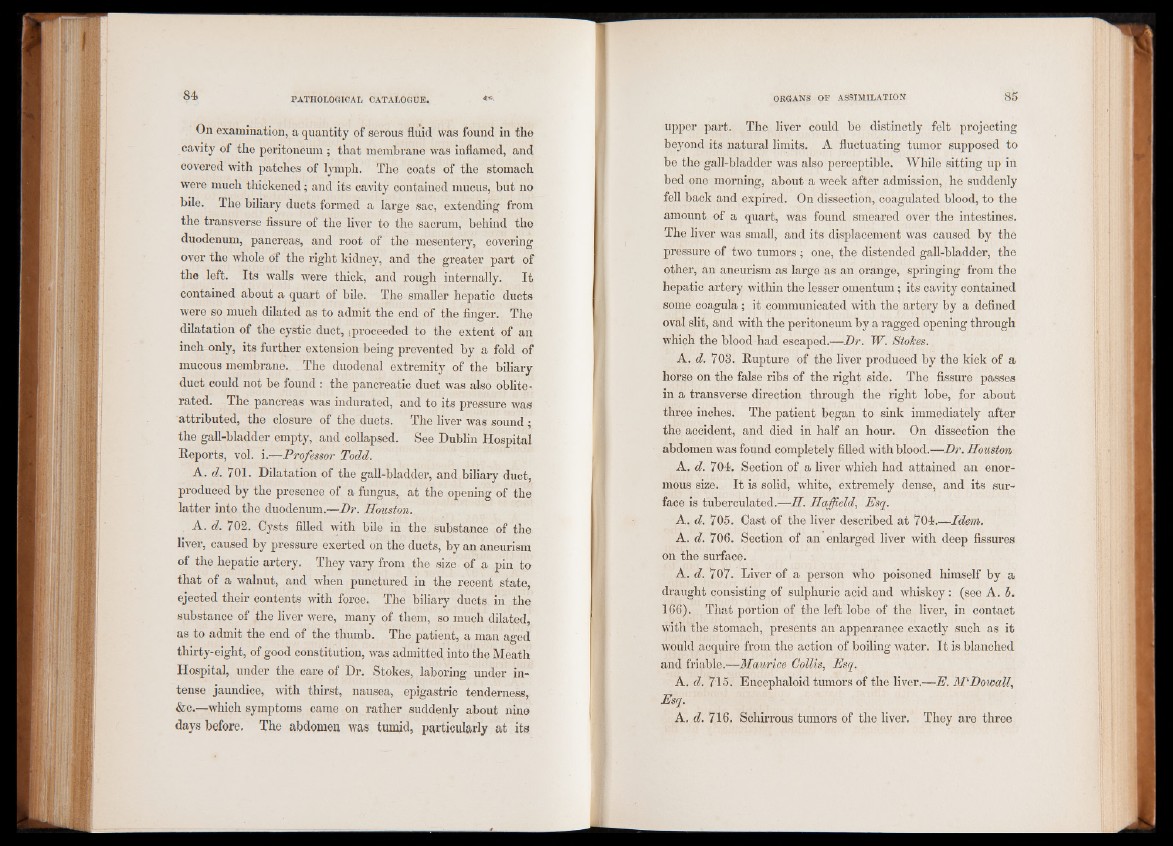
On examination, a quantity of serous fluid was found in the
cavity of the peritoneum; that membrane was inflamed, and
covered with patches of lymph. The coats of the stomach
were much thickened; and its cavity contained mucus, but no
bile. The biliary ducts formed a large sac, extending from
the transverse fissure of the liver to the sacrum, behind the
duodenum, pancreas, and root of the mesentery, covering
over the whole of the right kidney, and the greater part of
the left. Its walls were thick, and rough internally. It
contained about a quart of bile. The smaller hepatic ducts
were so much dilated as to admit the end of the finger. The
dilatation of the cystic duct, i proceeded to the extent of an
inch only, its further extension being prevented by a fold of
mucous membrane. The duodenal extremity of the biliary
duct could not be found : the pancreatic duct was also obliterated.
The pancreas was indurated, and to its pressure was
attributed, the closure of the ducts. The liver was sound ;
the gall-bladder empty, and collapsed. See Dublin Hospital
Reports, vol. i.—Professor Todd.
A. d. 701. Dilatation of the gall-bladder, and biliary duct,
produced by the presence of a fungus, at the opening of the
latter into the duodenum.—Dr. Houston.
A. d. 702. Cysts filled with bile in the substance of the
liver, caused by pressure exerted on the ducts, by an aneurism
of the hepatic artery. They vary from the size of a pin to
that of a walnut, and when punctured in the recent state,
ejected their contents with force. The biliary ducts in the
substance of the liver were, many of them, so much dilated,
as to admit the end of the thumb. The patient, a man aged
thirty-eight, of good constitution, was admitted into the Meath
Hospital, under the care of Dr. Stokes, laboring under intense
jaundice, with thirst, nausea, epigastric tenderness,
&c.—which symptoms came on rather suddenly about nine
days before. The abdomen was tumid, particularly at its
upper part. The liver could be distinctly felt projecting
beyond its natural limits. A fluctuating tumor supposed to
be the gall-bladder was also perceptible. While sitting up in
bed one morning, about a week after admission, he suddenly
fell back and expired. On dissection, coagulated blood, to the
amount of a quart, was found smeared over the intestines.
The liver was small, and its displacement was caused by the
pressure of two tumors ; one, the distended gall-bladder, the
other, an aneurism as large as an orange, springing from the
hepatic artery within the lesser omentum; its cavity contained
some coagula ; it communicated with the artery by a defined
oval slit, and with the peritoneum by a ragged opening through
which the blood had escaped.—Dr. W. Stores.
A. d. 703. Rupture of the liver produced by the kick of a
horse on the false ribs of the right side. The fissure passes
in a transverse direction through the right lobe, for about
three inches. The patient began to sink immediately after
the accident, and died in half an hour. On dissection the
abdomen was found completely filled with blood.—Dr. Houston
A. d. 704. Section of a liver which had attained an enormous
size. It is solid, white, extremely dense, and its surface
is tuberculated.—H. Haffield, Esq.
A. d. 705. Oast of the liver described at 704.—Idem.
A. d. 706. Section of an enlarged liver with deep fissures
on the surface.
A. d. 707. Liver of a person who poisoned himself by a
draught consisting of sulphuric acid and whiskey : (see A. i.
166). That portion of the left lobe of the liver, in contact
with the stomach, presents an appearance exactly such as it
would acquire from the action of boiling water. It is blanched
and friable.—Maurice Collis, Esq.
A. d. 715. Bncephaloid tumors of the liver.—E. M'Dowall,
Esq.
A. d. 716. Schirrous tumors of the liver. They are three